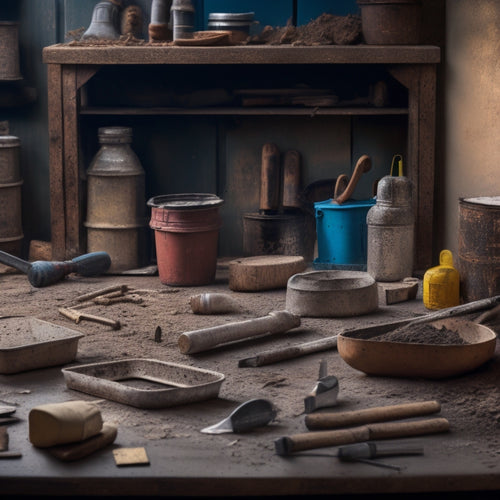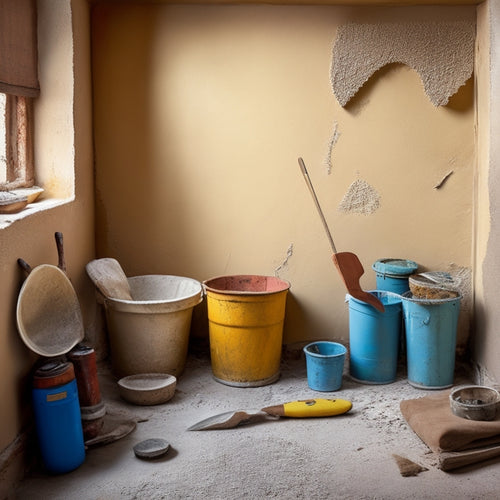
5 Finishing Tools to Complete Your Home Renovation
Share
You'll need five essential finishing tools to complete your home renovation: a trowel for applying thin layers of concrete, a bull float for flattening and smoothing surfaces, a concrete mixer for ensuring strong and consistent mixes, edging tools for creating clean and defined edges, and floating tools for removing imperfections. These tools will help you achieve a durable, long-lasting finish. By mastering their uses, you'll be able to move on to more advanced techniques, such as edging and jointing, smoothing and polishing, and sealing and protecting your concrete surfaces, ultimately bringing your renovation vision to life.
Key Takeaways
• Invest in a bull float for flattening and smoothing concrete surfaces to achieve a professional finish.
• Use edging tools to create clean, defined edges that enhance aesthetic appeal and durability.
• Select the right trowel type, such as v-notch or flat, to apply thin layers of concrete or spread it evenly.
• Employ floating tools to remove imperfections and ensure a durable, long-lasting finish.
• Choose the appropriate concrete mixer to ensure a strong, consistent mix of cement, water, and aggregate.
Essential Concrete Finishing Tools
When working with freshly poured concrete, you'll need a set of essential finishing tools to achieve a smooth, even surface. These include tamping tools, edging tools, and floating tools that help remove imperfections and create a durable, long-lasting finish.
Among the most critical tools in your arsenal are trowels, which come in various types. A v-notch trowel is ideal for applying a thin layer of concrete, while a flat trowel is better suited for spreading and leveling the material. You'll also need a bull float, a long-handled tool that helps to flatten and smooth out the surface.
To guarantee a strong, consistent mix, you'll need a reliable concrete mixer. A high-quality mixer will help you achieve the perfect blend of cement, water, and aggregate, resulting in a durable and long-lasting finish.
Edging and Jointing Made Easy
By employing edging and jointing tools, you can create clean, defined edges and control joints that not only enhance the aesthetic appeal of your concrete surface but also help to reduce cracking and improve its overall durability.
When it comes to edging techniques, you'll want to use an edger or a jointer to create a clean, 45-degree angle on your concrete surface. This will help to prevent chipping and cracking, while also creating a sleek, modern look.
For jointing methods, you can use a jointer or a groover to create control joints that will help to absorb any shrinkage or movement in the concrete. This will help to prevent cracking and guarantee that your concrete surface remains stable and durable.
By using the right edging and jointing tools, you can achieve professional-looking results that will enhance the overall appearance of your home renovation project.
With the right techniques and tools, you'll be able to create a beautiful, long-lasting concrete surface that meets your exacting standards.
Smoothing and Polishing-Concrete
You'll need to utilize specialized smoothing and polishing tools to refine your concrete surface, removing any imperfections or rough spots that may have developed during the edging and jointing process. This critical step guarantees a high-quality finish, and it's vital to get it right.
To achieve a smooth, even surface, you'll need to employ advanced smoothing techniques, such as using a concrete trowel or a power trowel to remove any excess material.
Next, you'll need to apply polishing products, like concrete polish or a chemical hardener, to enhance the surface's appearance and durability. These products can be applied using a variety of tools, including polishing machines, scrubbers, or even manual applicators.
Be sure to follow the manufacturer's instructions and take necessary safety precautions to avoid damaging the concrete or yourself.
Sealing and Protecting Concrete
Two primary factors for sealing and protecting concrete are selecting the appropriate sealant type and applying it correctly to guarantee a durable, long-lasting finish.
You'll want to choose a concrete sealer that suits your specific needs, taking into account factors such as the concrete's porosity, exposure to weather, and desired level of gloss. Acrylic, polyurethane, and epoxy-based sealers are popular options, each offering varying levels of surface protection and aesthetic appeal.
Once you've selected your sealer, it's essential to apply it correctly to assure a strong bond between the sealer and the concrete.
This typically involves cleaning the surface thoroughly, repairing any cracks or imperfections, and applying the sealer according to the manufacturer's instructions. You'll also need to evaluate the recommended application thickness, drying time, and any necessary re-coats.
Final Touches and Finishing
With the concrete sealed and protected, it's time to turn your attention to the final touches and finishing elements that will elevate your home renovation from functional to fabulous.
Now, you'll focus on adding decorative finishes that showcase your personal style. From elegant molding to statement lighting fixtures, these details will transform your space into a masterpiece.
When selecting final embellishments, consider the overall aesthetic you're aiming to achieve. Do you prefer modern and sleek or traditional and ornate?
Choose materials and textures that complement your design vision. For instance, if you've opted for a minimalist look, consider streamlined baseboards and sleek door handles. Conversely, if you're going for a luxurious feel, ornate crown molding and crystal chandeliers might be the way to go.
Frequently Asked Questions
Can I Use Finishing Tools on Freshly Poured Concrete?
You shouldn't use finishing tools on freshly poured concrete, as it's too soft and prone to damage.
Instead, wait until the concrete has reached its initial set, usually within 24-48 hours, depending on the mix and environmental conditions.
Then, you can employ fresh concrete techniques, such as floating, tamping, or edging, using specialized finishing tool types like tamping tools, edgers, or floats, to achieve the desired finish.
How Do I Choose the Right Finishing Tool for My Project?
When selecting a finishing tool, you'll need to take into account the type of tool and its compatibility with your project's material.
Are you working with concrete, wood, or metal? Different tools are designed for specific materials, so it's essential to choose the right one.
Research the various finishing tool types, such as trowels, edgers, and floats, and make certain the one you select is compatible with your project's unique requirements.
Do I Need to Rent or Buy Finishing Tools for My Renovation?
Don't assume you need to break the bank on finishing tools - you've got options.
If you're only using a tool once or twice, renting might be the way to go. You'll save on upfront costs and storage space.
On the other hand, if you're planning multiple projects, buying can be a better investment. You'll have the tool when you need it, and it'll be tailored to your specific needs.
Weigh the renting options against the buying advantages to make an informed decision that works for you.
Can I Use Finishing Tools on Non-Concrete Surfaces Like Wood or Metal?
When working with non-concrete surfaces, you'll need to adapt your finishing tools.
For wood finishing, you'll require specialized tools like orbital sanders and wood files to achieve a smooth finish.
Meanwhile, metal finishing demands more aggressive tools, such as metal grinders and sanding blocks, to remove imperfections.
Be sure to choose the right tool for the job to avoid damaging your surfaces.
Are Finishing Tools Safe to Use Around Children and Pets?
When working with finishing tools, you're right to wonder if they're safe around kids and pets. The answer is, it depends on you taking the right safety precautions.
You'll need to child-proof your workspace, storing tools out of reach and ensuring cords are secured.
Additionally, keep an eye on your little ones and furry friends, as even a moment's distraction can lead to accidents.
Conclusion
You've made it to the final stage of your home renovation! With the right finishing tools, you'll achieve a professional-looking result.
According to the National Association of Home Builders, 75% of homeowners consider a well-finished floor a top priority when buying or renovating a home.
By investing in these five essential concrete finishing tools, you'll be part of that majority, boasting a stunning and durable concrete surface that will last for years to come.
Related Posts
-

Top 3 Insurance Options for Home Renovation
When renovating your home, you need specialized insurance coverage to protect your finances from unexpected setbacks ...
-

Trowel Tool Cost for DIY Home Renovation Projects
When it comes to your DIY home renovation project, you'll need to budget for a variety of trowel tools, including stu...
-

Stucco Patching Material Checklist for Home Renovation
You'll need a range of essential tools, including a putty knife, wire brush, hawk or flat trowel, level, and straight...


